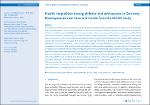Health inequalities among children and adolescents in Germany.
Developments over time and trends from the KiGGS study
Lampert, Thomas
Hoebel, Jens
Kuntz, Benjamin
Finger, Jonas D.
Hölling, Heike
Lange, Michael
Mauz, Elvira
Mensink, Gert
Poethko-Müller, Christina
Schienkiewitz, Anja
Starker, Anne
Zeiher, Johannes
Kurth, Bärbel-Maria
This study examines the extent to which health inequalities among children and adolescents in Germany have developed
over the past decade. The analyses are based on data from the German Health Interview and Examination Survey for
Children and Adolescents (KiGGS), which are representative of the 0- to 17-year-old population in Germany. The KiGGS
data were collected in three waves: the KiGGS baseline study (2003-2006), KiGGS Wave 1 (2009-2012) and KiGGS
Wave 2 (2014-2017). Prevalences of five health outcomes are considered: general health, mental health problems, physical
activity, the consumption of sugary soft drinks, and smoking. Moreover, it defines health inequalities in relation to
differences in the socioeconomic status of the family (SES), an index derived from the parents’ level of education,
occupation and income, and considers both absolute and relative health inequalities. In order to do so, the Slope Index
of Inequality (SII) and the Relative Index of Inequality (RII) were calculated using linear probability or log-binomial models.
Significant inequalities were identified to the detriment of young people from families with a low SES. These inequalities
were particularly pronounced in the KiGGS Wave 2 data with regard to general health and the consumption of sugary
soft drinks. Additionally, evidence from trend analyses for these two outcomes suggests that relative inequalities have
increased. However, absolute inequalities decreased during the same period, and this also applies to smoking.
The persistently high and, in some cases, widened levels of health inequalities indicate that adolescents from families
with a low SES do not benefit to the same extent from disease prevention and health promotion measures for children
and adolescents as young people from families with a higher SES.
Dateien zu dieser Publikation
Anmerkungen
Die deutsche Version des Artikels ist verfügbar unter: http://doi.org/10.25646/5867

